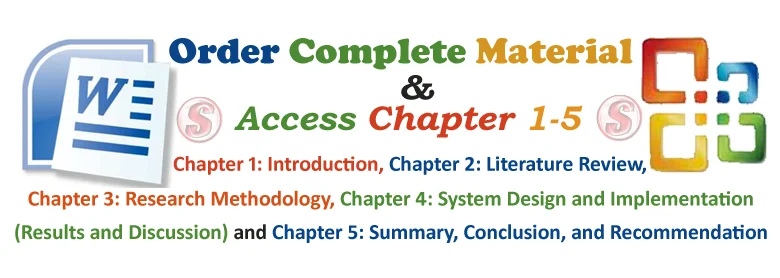1.1 Introduction
Computerized Appointment Scheduling System for Post Natal Patients refers to a digital platform or software application designed to facilitate the scheduling and management of medical appointments for mothers after childbirth. This system allows healthcare providers to automate the process of scheduling postnatal appointments, including check-ups, consultations, and follow-up visits. It typically includes features such as online appointment booking, automated reminders, real-time updates on appointment availability, and integration with electronic health records (EHR) systems. The primary goal of a postnatal appointment scheduling system is to improve efficiency in healthcare delivery, enhance patient access and satisfaction, and support better coordination of care between healthcare providers and postnatal patients.
As a prelude to other parts of this study, this chapter will discuss the background upon which this study was initiated, the statement of problems that led to this study, the Aim and Objectives of the study. Others are Significance of the study, Scope of work, Limitation of the study and Definition of technical terms.
1.2 Background of Study
Postpartum care is a service provided to individuals in the postpartum period, to help with postpartum recuperation and restoration. Traditionally, women were taken care of by their elders: their mother, mother-in-law, sister, or aunt. The lying-in hospitals provided an institutional variation which gave women weeks of bedrest and a respite from household chores. Increasingly, these older women are unavailable or unwilling to take on this role; given the lingering effects of the one-child policy, many older Chinese women had limited experience of newborn babies, having only had one themselves. Replacements for this familial help are commercial services, both in the home and at residential centres (Wikipedia, 2021).
The Post Natal also known as “Postpartum” appointment is commonly defined as the six weeks after childbirth arrangement to meet an health care worker such as; Doctors and Nurses, at a particular time in an hospital. This is a very important time for both the patient and her newborn baby as you adjust to each other and your expanded family. in the first few hours and days after childbirth, the patient will experience many changes, both physically and emotionally. Over the next six weeks or so, the patient's reproductive tract will slowly return to the way it was before she became pregnant. If the patient had a caesarean section, the patient's recovery will be different from that of a vaginal delivery (Aboutkidshealth, 2021).
During the Middle Ages (12th–16th century), the postpartum woman was considered unclean for 40 days after delivery (Troels-Lund 1940). Because the postpartum woman was unclean, she could contaminate both food and tools. In some places, it was believed that the postpartum woman could damage the work of others and, therefore, should not touch others' tools, particularly tools used by men (Blom 1988). It was also believed that both the baby and the mother were vulnerable to evil forces during the postpartum period and needed to be looked after (Troels-Lund 1940).
In the 1950s, there was a long lying-in period in the postnatal ward, with a lying-in period of 14 days being not unusual. In addition, many women with special needs could get home help paid by public funds in the Nordic countries. in the 1960s, the lying-in period was not to be less than 8 days (Eggerud and Eriksson 1991). There were many rules for the woman and baby. The woman had to rest in bed to become strong, and she was only permitted to see the baby every 4 hours, when it was time to breastfeed. One reaction to these rigid routines came at the end of the 1970s in the form of the “rooming in” system. The system was aimed at having the mother and baby together all of the time. In some places, the “rooming in” system was introduced where several mothers had to sleep in a multi-bedded room. We previously showed a clear correlation between the subjective experience of not getting enough sleep and the number of women per room (Eberhard-Gran et al. 2000).
Agencies provide specialist health care workers that come to the new parents' home. This job used to be known as the monthly nurse, as she came and lived with the family for a month. Now more common terms are maternity nurse, newborn care specialist, or confinement nanny; the worker is not a registered health care professional such as the word "nurse" usually implies in current English. In Indian English the role is called a "japa maid". A doula is best known as a birth companion, but some provide practical and emotional post-birth support. A lactation consultant and a health visitor are trained health professionals who may assist the new mother at this time. in the Netherlands, the in-home support is known as kraamzorg, and standard within the national health insurance system (Wikipedia, 2021).
Common registers that are used in the hospital setting are the admission register, discharge register, and death register. Just as the name implies, these registers list the admissions to the hospital, the discharges from the hospital, and the deaths that occurred while hospitalized. Registers and registries provide the facility, as well as the providers and public health officials, with information needed to assess and monitor the health given in a particular population.
Patient appointment records contain most crucial documents for managing the treatments and healthcare of patients in the hospital. Care providers waste precious time searching and browsing the patient record to collect all information pertinent to the actual situation.
The challenges encountered that led to the execution of the research work is that, care providers waste precious time searching and browsing for unscheduled patient record to collect all information pertinent to the actual situation, Difficulty in accessing certain patient file location, the manual system of post natal appointment scheduling of patient is usually stressful and may result to an incomplete daily scheduling of appointment with post natal patients, and Inaccuracies in patient's medical record keeping due to human errors.
It is against the background that the developments of this software to enable health workers schedule appointment meet-ups with post natal patients, so the software users should not give false appointment information that is out of the software deeds. This research work is based on providing adequate information about medical records. At the end of this project, the research work, the software will be able to provide precise and concise patient records from the database.
1.3 Statement of Problems
Investigation revealed the challenges encountered that led to the execution of the research work include the following;
- Care providers waste precious time searching and browsing for unscheduled post natal patient record to collect all information pertinent to the actual situation,
- Difficulty in accessing certain post natal patient file location,
- The manual system of post natal appointment scheduling of patient is usually stressful and may result to an incomplete daily scheduling of appointment with post natal patients, and
- Inaccuracies in post natal patient's medical record keeping due to human errors.
1.4 Aim and Objectives of the Study
The aim of the study is to design an application that will eradicate the existing problems of the post natal appointment scheduling system. In achieving this aim, the specific objectives below will be adhered to;
- Develop an application that will enable the care providers search and browse post natal patient record without delay.
- Store post natal patient file record in a database that will enable care providers to be able to locate patient files in the health facility.
- Develop an application that will accurately schedule multiple patient daily appointment meet-up with reference to time.
- Develop an application that will provide accurate post natal patient's start time and end time with the post natal health worker.
1.5 Significance of Study
This system when completed and implemented it will help provide adequate information about post natal patient's medical record and facilitates quick medical appointment scheduling. This project will be beneficial to individuals such as: pregnant women, pharmacist and doctors, nurses, care providers by providing accurate and complete information about post natal patient's medical record thereby saving patient time during post natal medical checkup. Besides, the study will serve as reference material for subsequent researcher in the field or related topics.
1.6 Scope of Study
The study focuses on the design and implementation of post natal appointment scheduling system, using Federal Medical Centre (FMC), Owerri, Imo State as a case study.
1.7 Limitations of the study
During the course of this study, many things militated against its completion, some of which are:
- Time Constraint: The time frame given to accomplish this project was very short due to school academic calendar and it was carried out under pressure which made the researcher not to implement some necessary features.
- Establishment Policies: Establishment policies posed a serious limitation as most staffs are not ready to release information needed for this project work. There were lots of information needed from the staffs of this institution to enhance the study which took them time to release or they did not release at all for security purposes, hence the scope was reduced.
- Research material: availability of research material is a major setback to the scope of the study.
- Frequent power failure: This made the researcher append more money on fuel to ensure sustainable power.
- Financial Constraint: Insufficient fund tends to impede the efficiency of the researcher in sourcing for the relevant materials, literature or information and in the process of data collection (internet).
1.8 Definition of Terms
Medication: A medication is a substance that is taken in to or placed on the body that does one of the following things: most medications are used to cure disease or condition. (For example, antibiotics are given to cure an infection. Medications are also given to treat a medical condition).
Prescription: A prescription is a health-care program implemented by a physician or other qualified health care practitioner in the form of instructions that govern the plan of care for an individual patient.




